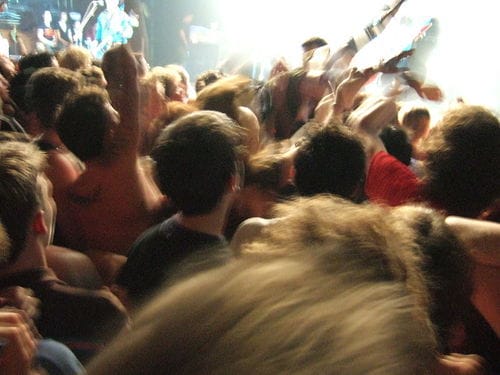Matt Bierbaum is a graduate student in physics at Cornell and a fan of mosh pits. So when he stayed out of the pit while attending a concert one day, his science instincts kicked into high gear. What he noticed, which is now published in a paper he co-authored and entitled “Collective Motion of Moshers at Heavy Metal Concerts” (pdf), is that moshers tend to follow rules of collective action following one of two behavioral patterns: the movement of molecules in a gas, or the swarm patterns seen in schools of fish and flocks of birds.
(For the uninitiated, moshing entails thrashing around to the beat of music like heavy metal, bumping off other people in a densely packed “mosh pit.”)
Flocks of birds and schools of fish can collectively change direction quickly as if God commanded them all at the exact same instant to “turn left!” But their movement arises from each animal following a simple set of three rules, a “short-range repulsive behavior, an intermediate range desire to align with neighbors, and a long-range attraction to the group as a whole.” Using a model like these three rules, the swarm behavior of fish and birds can be modeled mathematically.
Although men and women do not follow these rules as they saunter down the street or walk across the office to the restroom, researchers working on swarm behavior have noted that the model does apply to humans in densely packed situations:
“Even though large groups of individuals may have their own thoughts and desires, when brought together, collective behavior spontaneously emerges. Also, what looks chaotic and complex at first glance can be explained, at least partially, by a simple set of mathematical rules.”
Many situations in which collective behavior arises are emergency situations such as riots and escaping burning buildings. Researchers would like to use their mathematical models to better understand collective behavior in these situations, but there is one problem: “It would be unethical to pack a large number of people into a space and deliberately cause a panic just to see if one model works better than others.” Architects are unlikely to redesign buildings’ fire escapes based on models that cannot be tested and verified.
That’s where mosh pits come in. Since they are a safe (relatively, at least) environment that researchers can study, they could help scientists study collective behavior in humans. As Bierbaum and his co-authors write (pdf):
“Further studies in this unique environment may enhance our understanding of collective motion in riots, protests, and panicked crowds, leading to new architectural safety design principles that limit the risk of injury at extreme social gatherings. Moreover, these concerts have the further advantage of exhibiting a rich variety of states such as the wall of death…”
This post was written by Alex Mayyasi. Follow him on Twitter here or Google.





